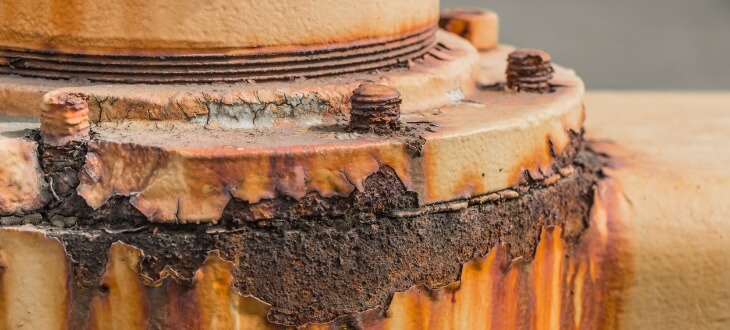When two different metals come into contact in the presence of an electrolyte — such as water, humidity, or salt — a natural electrochemical reaction occurs. This process, known as galvanic corrosion, causes one metal to corrode faster (the “anode”) while the other is protected (the “cathode”).
Over time, this reaction can weaken structures, damage finishes, and reduce the lifespan of valuable materials and components. Whether you’re working on a large commercial project or a small fabrication job, understanding galvanic corrosion is essential to maintaining strength, safety, and quality in your work.
What is Galvanic Corrosion?
Galvanic corrosion occurs when three key elements come together:
- Two dissimilar metals
- An electrical connection between them
- An electrolyte, such as water, that allows ions to flow
When these conditions exist, electrons flow from the more active metal to the more noble metal. The active metal sacrifices itself, corroding faster than it would alone.
Several environmental and material factors can accelerate this reaction:
- Incompatible metals: When metals with different electrochemical potentials (like aluminum and steel) touch, electrons transfer between them, leading to accelerated corrosion.
- Moisture and humidity: Water, condensation, or saltwater acts as an electrolyte, speeding up the process.
- Temperature: Heat increases chemical activity, which makes corrosion occur faster.
- Environmental exposure: Outdoor installations, marine applications, or industrial settings with pollution or chemicals increase the risk.
Even small hardware — bolts, screws, or welds made from a different alloy than the main structure — can trigger corrosion over time.
Metallic Compatibility: Choosing the Right Materials
When working on any fabrication or construction project, metal compatibility is key to preventing galvanic corrosion. The farther apart two metals are on the galvanic series, the more likely one will corrode when paired.
Here are a few practical guidelines to keep in mind:
- Pair similar metals whenever possible. For example, stainless steel fasteners with stainless steel panels.
- Avoid pairing highly active metals (like zinc, aluminum, or magnesium) with more noble metals (like copper, brass, or stainless steel).
- Use insulating materials such as rubber gaskets, plastic washers, or non-conductive coatings to break the electrical path between metals.
- Check the galvanic series chart during the design phase to identify which combinations are safe.
By selecting the right metals and protective materials early on, you can save significant time and money later in maintenance and repairs.
Real-World Example: Galvanic Corrosion in Action
A classic example of galvanic corrosion can be seen when aluminum panels are fastened with steel bolts. Because steel is more noble, the aluminum becomes the anode and begins to corrode first. The result is often visible as white powder or pitting around the fasteners.
In marine environments, galvanic corrosion is even more aggressive. Saltwater serves as an excellent electrolyte, accelerating the reaction between incompatible metals. That’s why boats, docks, and coastal structures often require extra attention to material selection, protective coatings, and ongoing inspection.
Even in everyday projects — such as handrails, outdoor furniture, or custom metalwork — these same principles apply. Understanding the causes of galvanic corrosion helps ensure your finished product looks great, performs safely, and stands the test of time.
How to Prevent Galvanic Corrosion
Fortunately, preventing galvanic corrosion doesn’t have to be complicated. With the right planning, you can keep your materials strong and your projects looking their best for years to come.
Here are a few effective prevention tips:
- Select compatible metals based on the galvanic series and project environment.
- Apply protective coatings such as paint, plating, or anodizing to isolate the metal surfaces.
- Use dielectric insulators like sleeves, gaskets, or washers to physically separate dissimilar metals.
- Design for drainage so that rainwater or condensation doesn’t pool around joints or fasteners.
- Regularly inspect and maintain metal connections, especially in humid or coastal locations.
When you design with corrosion prevention in mind, you protect not only your materials but also your reputation for quality craftsmanship.
Why This Matters for Builders and Fabricators
For fabricators, welders, and contractors, galvanic corrosion isn’t just a chemistry concept — it’s a real-world issue that impacts performance, safety, and profitability. Rusted connections, weakened joints, or unexpected maintenance costs can delay timelines and add expenses to your bottom line.
That’s why working with a trusted metal supplier who understands these challenges is so important. The team at Tampa Steel & Supply has decades of experience helping professionals choose the right metals and finishes for every application — from heavy construction to ornamental design.
Whether you’re sourcing steel beams, sheet goods, or custom plasma-cut components, we can guide you toward the materials that will stand the test of time.
Reach Out to Tampa Steel & Supply Today
Want to learn more about galvanic corrosion and how to choose compatible metals for your next project? Tampa Steel & Supply is here to make your vision a reality! Stop by our warehouse or contact us for a quote — we’ll walk you through the process to help you reach your goals.
We also offer a comprehensive range of premium steel products, custom fabrication services, and nearly 40 years of experience supporting builders and manufacturers across Tampa Bay.
Request a quote online or call Tampa Steel & Supply at (813) 241-2801.

